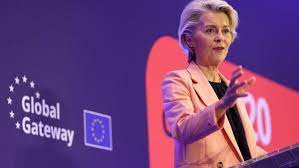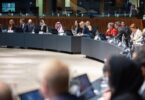Andrew Hammond
The last few days have been something of an unofficial global infrastructure week, with the 10th anniversary of China’s Belt and Road Initiative being marked in Beijing and the EU officially launching its new Global Gateway project in Brussels on Wednesday.
Inevitably, much reportage has focused on the geopolitical ramifications of these two developments. Very important as these are, however, organizations ranging from McKinsey to the Asian Development Bank have highlighted that these massive projects do not — inevitably — have to be competitive.
The Asian Development Bank, for instance, sees an infrastructure investment gap of some $26 trillion in that area of the globe alone in the period to 2030. To put this into perspective, even if China were to double the BRI’s investment total in this period, it would still leave financial capacity for many multiples of the EU’s Global Gateway scheme, which aims to mobilize up to €300 billion ($317 billion) in public and private investments worldwide in the period from 2021 to 2027.
Yet, despite these core facts, the primary lens through which the BRI and the Global Gateway are often perceived is geopolitical. While the BRI has secured massive media coverage over the last decade, the Global Gateway project has operated far more under the radar, despite being widely seen as Europe’s most significant response to the BRI to date.
While the Global Gateway is politically led in Brussels, it aims to mobilize funds to finance EU infrastructure projects abroad. The €300 billion target is based on national and EU resources from financial institutions and development banks, with the hope that institutional spending will also unlock significant private capital. The role of the private sector is cemented in the EU scheme by the business advisory board, which includes a wide range of firms, including in the energy, transport and digital sectors.
Geographically, the project is focused on Latin America and the Caribbean, the Middle East, the Asia-Pacific and Africa. These target regions broadly align with the EU’s goal of diversifying its supply chains, given its high dependence on several key countries, including China. Political leaders from more than a dozen developing nations attended Wednesday’s launch in Brussels, including Armenia, Comoros, Namibia, Mauritania, Senegal, Somalia, Albania, Bangladesh, the Democratic Republic of the Congo, Egypt, Georgia, Moldova, Morocco, Rwanda and Serbia.
While projects in Africa and Latin America have already been given significant media attention, what are perhaps less well known are those in the Middle East and the Asia-Pacific. Given the intensifying geopolitical competition in these regions, the EU is stepping up its strategic engagement there. The growing economic, demographic and political weight of these areas make them key collaborators in the shaping of the rules-based international order and in addressing key global challenges such as climate change.
Potential projects in the Middle East include a water desalination scheme in Jordan, which will enhance water security in a nation that is increasingly being hit by the impact of global warming. There is also a potential digital project for businesses and universities in Egypt and several neighboring nations that would boost internet speeds via a submarine cable.
Beyond these examples, the Global Gateway’s areas of focus include climate and energy, with investment in both mitigation and climate resilience, as well as in clean energy, especially in low- and middle-income countries. Key goals with this include helping to deliver energy security, achieve the UN Sustainable Development Goals and meet Paris climate treaty targets.
Another area of focus is health, with a goal of strengthening capacity around the world. This will prioritize the security of pharmaceutical supply chains and development of local manufacturing. The COVID-19 pandemic revealed weaknesses in healthcare systems and the fragility of pharmaceutical supply chains. It also highlighted the wide discrepancies in medical manufacturing capacities around the world. Yet another example is transport, with the Global Gateway having a goal of creating sustainable, smart, resilient, inclusive and safe transport networks. In Africa, the goal is to help enable the economic potential of a continental trade area.
Creating such strategic, sustainable and secure transport corridors and supporting value chains, services and jobs will benefit industries in both Africa and Europe. The proposed strategic corridors will use reliable networks and services to provide better, greener EU-Africa connectivity. These corridors will facilitate trade and mobility within Africa as well as between Africa and Europe.
One of the transport networks that the EU is, alongside the US, keen to develop is the so-called Lobito corridor, which seeks to connect the Angolan coast to Zambia and the Democratic Republic of the Congo, which are home to major deposits of cobalt, lithium and copper. These three African countries in July committed to the project, which will join the mineral-rich Congolese province of Katanga with the Atlantic port of Lobito in Angola, via the copper belt in Zambia.
The launch of the Global Gateway strategy is the latest signal of a new, geopolitical EU. While the project currently has far less funding than the Chinese BRI, it nonetheless signals a step change in Brussels’ approach to trying to protect its political, economic and security interests, while projecting a strong and competitive bloc to the outside world.







